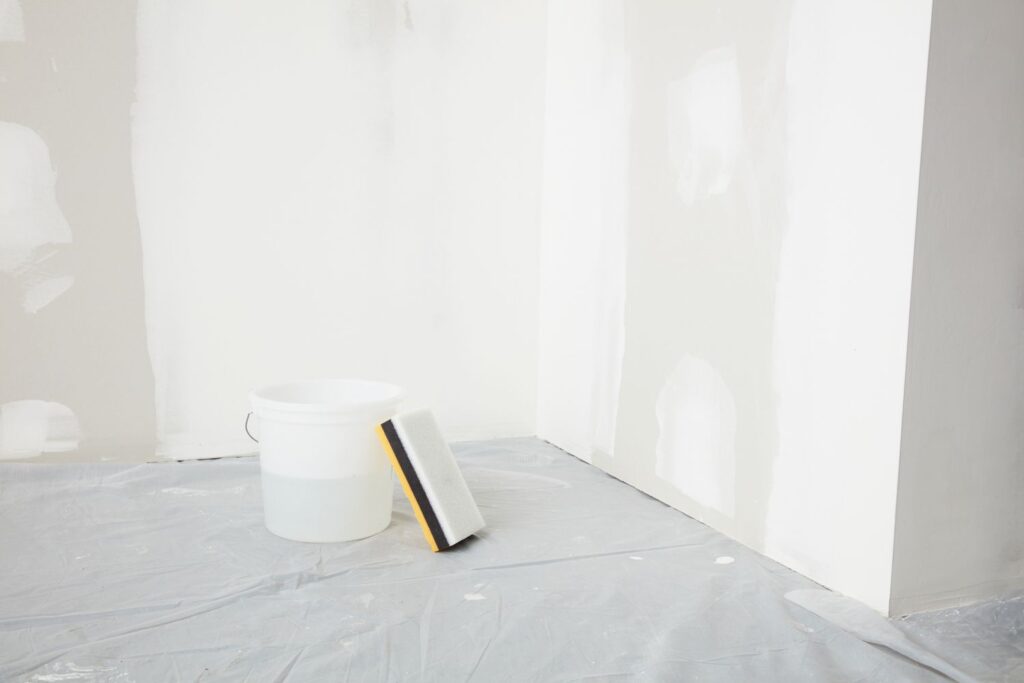Hanging drywall is a straightforward project, but the main reason why more DIYers don’t install and finish drywall themselves is how much fine dust it produces. You can reduce your dust output to nearly zero using a wet-sanding method.
This process is far from precise. It doesn’t leave you a perfectly smooth surface and is much slower than traditional sanding. But it’s one of the best ways to prevent dust from taking over the space.
What Is Wet-Sanding?
Wet-sanding requires a damp sponge to smooth out and remove excess taping compound after it dries. When moistened with a sponge, the drywall compound begins to dissolve and loosen, and it can then be smoothed out. Wet-sanding is usually done with a very thick, stiff sponge.
The Spruce / Margot Cavin
The Dust Problem
Drywall dust is so incredibly fine and invasive that the warranties of some house vacuums are considered void if you use them to remove drywall dust.
Even the most careful taping and mudding job requires that the joints be sanded with a sanding screen or sandpaper, and that action invariably creates dust that flies everywhere and gets into everything. It travels into the farthest regions of your home and deep into your clothes and hair.
When cleaning up drywall dust, even good eye protection and a particle mask don’t entirely prevent the superfine powder from entering your eyes and lungs.
Pros and Cons of Wet-Sanding
Many drywall professionals view wet sanding more as “joint smudging” than actual sanding since so much of the taping compound remains on the wall rather than your sponge. But there can be real value to smudging out the edges of the joints because it makes the seams less visible or even invisible after painting.
If you’re interested in speed, wet-sanding is the slower way to go without giving you a perfectly smooth surface. Because you are using a sponge―which is flexible―your finished wall may exhibit gentle waves.
If you wipe down the walls too vigorously with a too-wet sponge, you can dissolve and remove too much of the taping compound, requiring you to go back and apply more mud. But all of these drawbacks may be worth the significant benefit—a joint-smoothing operation completely without dust.
Instructions
How to Wet-Sand Drywall
-
Wet the Sponge
- Fill a bucket with warm water.
- Dip the sponge into the water, and then wring it out. Drywall sponges can become almost bone-dry if you wring too hard, Wring the sponge so it is not sopping but still noticeably damp. The sponge must be damp enough to dissolve and loosen the hardened joint compound.
Credit: The Spruce / Margot Cavin
-
Sand the Joint With the Abrasive Sponge Side
- Begin by knocking down any obvious high spots with the abrasive side of your sponge. Move the sponge in broad, circular strokes. Don’t press too hard in any one spot, as this can create depressions in the joint compound. Concentrate on the dried compound’s high ridges and spiky areas.
- When the sponge gets bogged down with compound or looks gritty, rinse it out and continue with a newly dampened sponge.
Credit: The Spruce / Margot Cavin
-
Sand With the Smooth Side of the Sponge
- Wring out the sponge, then remoisten it, and switch to sanding with the smooth side of the sponge.
- Feather the joint compound outward from the joints. This will reduce the visibility of seams after painting.
- By this point, you should have already taken down the high ridges. Concentrate on lowering the joint compound bump.
- After this second pass, you are done. Any more wet sponging will get the drywall paper too wet. Dry-sand the joint compound if two passes are insufficient.
Credit: The Spruce / Margot Cavin
-
Let the Wall Dry and Inspect
Check your work. One thing that wet-sanding does that dry-sanding does not: It moistens dried mud compound, thus “reactivating” it and moving it to other parts of the wallboard. This reactivation allows you to smooth out and feather the ridge edges.
- Let the damp taping compound dry thoroughly.
- Inspect the surface. Compare the “before” joint with the “after” joint. The “before” joint has a defined line. Running your finger across this line, you feel a definite ridge. On the “after” joint, you should notice a smooth, hazy feathering effect.
- If the seam ridge is too high and shows through the paint, you might need to dry-sand the wall to make it smooth.
Credit: The Spruce / Margot Cavin
FAQ
-
What is wet-sanding?
Wet-sanding adds a moisture component—often simply water—to the sanding process. The moisture helps to lubricate the surface and capture sanded particles, so there’s less of an opportunity for the particles to scratch the surface or become airborne.
-
Is wet-sanding drywall better?
The main perk to wet-sanding drywall is it creates less dust than dry-sanding. However, it typically doesn’t result in as smooth of a finish as dry-sanding.
-
How do you sand drywall like a pro?
The key is to pay attention to your sanding motion. Work in even circulation strokes from the center outward to blend the edges into the rest of the wall.
-
How do you clean drywall dust after sanding?
With either sanding method—wet or dry—you’re going to create some dust. You can use tack cloth to lightly wipe the walls, or brush them with a soft-bristle brush. Then, use a shop vacuum to clear dust from the area.
Read the full article here
